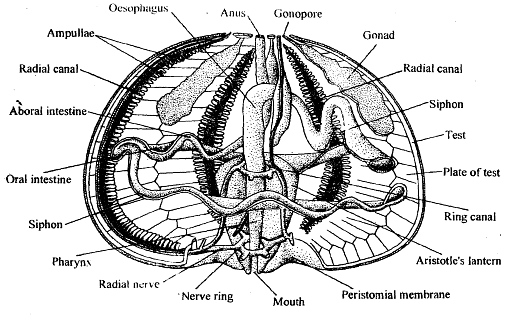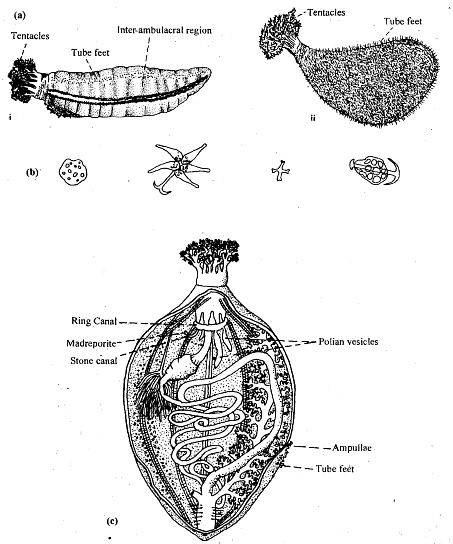Echinodermata: Locomotion | Zoology Optional Notes for UPSC PDF Download
| Table of contents |

|
| Locomotion in Echinoderms: The Water-Vascular System |

|
| Structure of the Water-Vascular System |

|
| Accessory Structures |

|
| Locomotion and Functions of Tube Feet |

|
Locomotion in Echinoderms: The Water-Vascular System
Echinoderms, a phylum of marine animals, employ a unique system known as the water-vascular system for locomotion. This system, characteristic of echinoderms, consists of a series of coelomic canals containing fluid. The system allows sea water to enter via a perforated plate called the madreporite on the aboral side of the animal. The fluid within the system closely resembles seawater but has a higher potassium ion content and contains various proteins and amoebocytes.

Structure of the Water-Vascular System
The structural organization of the water-vascular system is fundamentally consistent among echinoderms, with slight variations. A classic example is the starfish, which showcases the primary components relevant to locomotion.

- Ambulacral Ring Canal: This pentagonal circumoral vessel forms the core of the system. It serves as the central hub for the rest of the canal network.
- Radial Vessels: Five radial canals extend from the ambulacral ring canal, each extending to the tip of an arm. Along their course, they give rise to numerous side vessels.
- Side Vessels and Tube Feet: These side vessels connect to tube feet (podia), which are hollow, conical or cylindrical structures equipped with an ampulla and a terminal sucker. A valve is present at the junction of lateral vessels with the tube foot. Tube feet serve as the key organs for locomotion, among other functions.
- Madreporic Canal (Stone Canal): This canal extends vertically between the circumoral ring canal and the madreporite situated aborally. The presence of calcareous deposits in the canal wall gives it the name "stone canal."
Accessory Structures
Several accessory structures are associated with the water-vascular system:
Polian Vesicles: These pear-shaped appendages are attached to the ring canal in inter-radial positions. They possess long necks and thin walls, and are believed to be involved in regulating fluid pressure within the system and in producing amoeboid cells.
Tiedemann's Bodies: This pair of small glandular structures is found near the neck region of the Polian vesicles, with two in each inter-radius (except where the madreporite is present). Their exact function is still under investigation, but they are considered to be lymphatic glands.

Locomotion and Functions of Tube Feet
Tube feet serve multiple functions in echinoderms, which include locomotion, feeding, respiration, and sensation. They can have various forms and adaptations depending on the species.
- Tube Feet for Locomotion: Tube feet are usually equipped with a terminal sucker and are highly muscular. They serve as the primary means of locomotion in many echinoderms, allowing them to crawl, climb, and move along hard surfaces.
- Suctorial Tube Feet: Some echinoderms, like certain species of asteroids, have tube feet with suckers, which they use for climbing, descending, and capturing food.
- Peg-Like Tube Feet: In species that inhabit soft, muddy surfaces, tube feet may have a peg-like appearance with pointed tips. These tube feet are employed for digging, walking, and other activities.
- Tube Feet in Ophiuroidea: In brittle stars (ophiuroids), tube feet are reduced and mainly function as non-suctorial sensory tentacles. Locomotion in these echinoderms is achieved through the whip-like movement of their flexible, long arms.
- Echinoidea and Holothuroidea: Sea urchins and sea cucumbers also use their tube feet for locomotion. In sea urchins, the tube feet are used for anchoring and moving along vertical surfaces, aided by their spines.
- Crinoidea: Feather stars and sea lilies from this class lack the typical tube feet and instead have long, whip-like tentacles that assist in capturing planktonic food. Most crinoids are sessile, but stalkless comatulids can swim and crawl by manipulating their arms.
Overall, the water-vascular system, with its fluid-filled tube feet, plays a vital role in the locomotion of echinoderms. The hydraulic pressure generated by this system enables the extension and adhesion of tube feet, allowing these unique marine animals to move, albeit at a slow pace compared to other animals.
|
181 videos|351 docs
|















